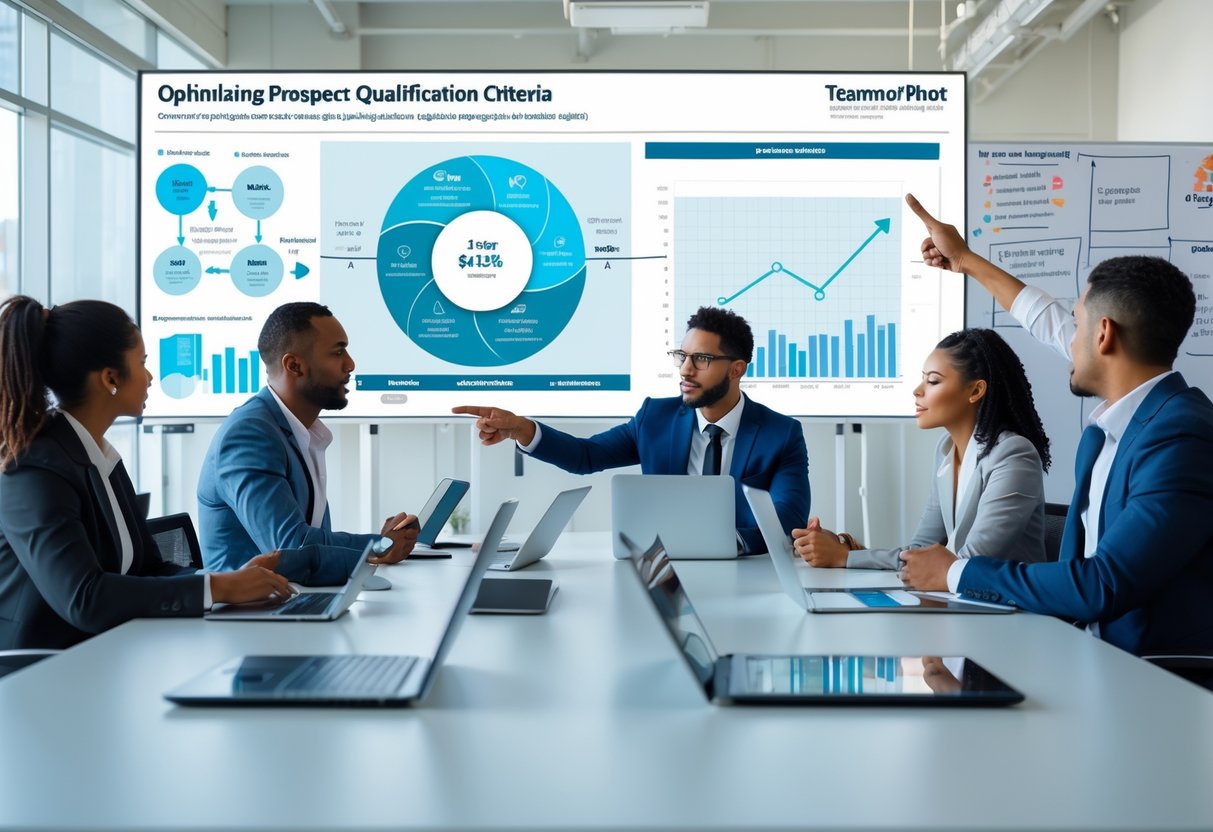When I qualify prospects, I look for clear signs that someone’s actually serious about buying—not just window shopping.
Prospect qualification criteria help me figure out where to put my energy and which deals are worth chasing. Without this, I’d waste a ton of time on leads that’ll never go anywhere.

I pay close attention to things like budget, authority, need, and timing. But honestly, I also just try to see if their problems actually match what I can fix.
By asking the right questions and just listening, I can spot the real buyers and skip the rest.
Structured methods like BANT or MEDDIC give me a roadmap, but I tweak them for my style and market.
If you want to skip all this hassle, feel free to contact me on Whatsapp for consultation or to buy qualified leads: +917303556188. Why stress over prospecting when you can get ready-to-go leads from someone who does this every day?
Key Takeaways
- Prospect qualification criteria show who’s actually worth your time
- Having a process makes everything smoother
- Tweaking frameworks for your own market works best
Understanding Prospect Qualification Criteria
I use qualification criteria to make sure I’m not just spinning my wheels. By setting real standards, I can spot who’s just curious and who’s ready to buy.
Definition of Prospect Qualification
When I say prospect qualification, I’m talking about figuring out if someone actually fits the mold of a legit customer.
I check for budget, authority, needs, and timing. I usually lean on frameworks like BANT or CHAMP to keep things on track.
These frameworks help me ask the right stuff and stop wasting energy on people who’ll never buy.
Prospect qualification criteria I look at:
- Company size
- Industry and location
- Pain points or challenges
- Decision-making authority
- Available budget
With these, I can quickly decide if I should keep talking or move on.
Importance in the Sales Process
Qualification acts like a filter—it keeps my sales pipeline clean.
If I don’t qualify, I end up chasing ghosts. Formal qualification methods boost conversion rates and speed things up.
Using clear qualification criteria means I spend my time with the right people.
Benefits? Higher close rates, better resource use, and way more accurate forecasting.
Key Differences Between Leads, Prospects, and Opportunities
I break it down like this: a lead shows early interest—maybe they filled out a form or grabbed a freebie.
A prospect actually ticks the boxes. They need what I offer, can afford it, and want it soon.
An opportunity is a qualified prospect who’s in the thick of deciding. That’s when I focus on solutions and closing.
| Stage | Definition | My Focus |
|---|---|---|
| Lead | Early interest, unqualified | Collect info, nurture |
| Prospect | Meets qualification criteria | Engage, validate fit |
| Opportunity | Active buying process, high intent | Close the deal, add value |
Keeping these straight saves me headaches and keeps my sales process tidy.
Core Criteria for Qualifying Prospects
I always look at three main things: can they pay, can they say yes, and do they actually need what I’m selling?
Each one helps me avoid wasting time and lets me focus on real deals.
Budget Assessment
First thing—I check if they’ve got the money. No budget? No deal.
I’m upfront about pricing so nobody’s surprised. If there’s a mismatch, I don’t push; I might even point them somewhere else.
Here’s my quick checklist:
- Can they pay now?
- Do they get how I charge?
- Will the budget flex if the scope changes?
This way, I move fast and stick with people who are ready to buy.
Decision-Making Authority
I need to know if I’m talking to the real decision-maker.
If I’m stuck with someone who can’t approve, things drag on forever. I always ask, “Who else is involved in this decision?” or “What’s your role in approvals?”
If I hit a gatekeeper, I work to earn trust but also try to get to the boss. Best practices say skipping this step wastes tons of time.
Identifying Pain Points
If I don’t know their real problems, I can’t help them. I ask open-ended stuff like:
- What’s your biggest headache right now?
- What have you tried already?
- How’s this hurting your business?
If their pain matches what I fix, I know I’m in the right place. If not, I move on or suggest someone better.
Popular Qualification Frameworks

I lean on frameworks because they help me ask the right things and avoid dead ends.
Each one has its own flavor, but the goal’s always to qualify faster and smarter.
BANT Methodology
BANT stands for Budget, Authority, Need, and Timeline. It’s old school, but it works.
- Budget: Do they have money?
- Authority: Am I talking to the boss?
- Need: What’s the problem?
- Timeline: When do they want to move?
BANT’s great for quick checks, but sometimes it feels a bit stiff. Ask about budget too soon and you might scare people off. Still, for fast filtering, it’s handy.
MEDDIC Framework
MEDDIC is more detailed, perfect for complex sales.
It stands for Metrics, Economic Buyer, Decision Criteria, Decision Process, Identify Pain, and Champion.
- Metrics: What results can I deliver?
- Economic Buyer: Who holds the purse strings?
- Decision Criteria: What do they care about?
- Decision Process: What’s the approval path?
- Identify Pain: What’s making this urgent?
- Champion: Who’s rooting for me inside?
I use MEDDIC when I need to get every detail right. It helps me build a strong business case and avoid surprises. People say it’s one of the most effective frameworks out there.
CHAMP Approach
CHAMP flips things around—it starts with the prospect’s challenges.
It stands for Challenges, Authority, Money, and Prioritization.
- Challenges: What do they need fixed?
- Authority: Who decides?
- Money: Is there a budget or a way to get one?
- Prioritization: How urgent is this?
I like CHAMP because it’s more about helping the buyer, not just ticking my boxes. It’s especially good in crowded markets where you need to stand out by actually caring about the customer’s problems. Check out the CHAMP framework if you want to see how it works.
Evaluating Fit and Need

I always ask: does this buyer’s problem match what I solve? And do they need help now, or can they wait forever?
Product-Market Fit
First, I check if they fit my ideal customer profile. That means looking at industry, company size, and goals.
If they’re not a match, even the best lead might fizzle out.
I also see if their pain lines up with what I actually fix. For example, if my product speeds up workflows, I want to hear they’re struggling with slow processes.
If their issues don’t match, I let them go.
My quick checklist:
- Are they in my target market?
- Does my solution solve their problem?
- Do they have the resources to benefit?
Frameworks like Ideal Customer Profile and BANT help me filter out bad fits early.
Timing and Urgency
I ask how fast they need a solution.
If the problem’s urgent, they’ll have a budget and timeline ready. If not, they’ll drag their feet.
I ask about deadlines, current pain, and any events that make this urgent.
If they admit waiting costs them money or time, that’s a green light. If not, I know it’s a long shot.
Using opportunity-level qualification helps me avoid chasing leads that aren’t ready.
Why spend months qualifying and chasing leads when you could just buy them from someone who does this day in, day out? If you want to cut the nonsense and get right to closing deals, feel free to contact me on Whatsapp at +917303556188. I’m happy to chat, and honestly, it’s just easier this way.
Optimizing the Qualification Process

I’m all about asking the right questions and using smart tech to keep things moving. Every day, I look for ways to tweak my approach so I can spot the best prospects and keep my pipeline humming.
Effective Discovery Questions
Discovery questions are my go-to for figuring out if a lead’s even worth chasing. I’ll ask about budget, who’s actually making decisions, and what headaches they’re dealing with.
If someone tells me their timeline, I’m listening. A simple, “When are you planning to implement a solution?” can reveal a lot—sometimes it’s a hot lead, sometimes it’s just wishful thinking.
To keep things on track, I lean on frameworks like BANT or MEDDIC. These keep my conversations tight and stop me from wasting hours on dead ends.
Leveraging CRM Tools
CRM tools make my life way easier. I track every call, score leads, and even automate the boring stuff.
If a prospect opens my emails or asks for a demo, my CRM flags them. That’s a good sign—they might actually be ready to buy.
With lead scoring, I can spot who matches my ideal customer profile. I don’t want to chase every random contact, just the ones who fit. Tools like Rox’s Agentic CRM even nudge me with real-time prompts, so I can make decisions fast.
I jot down notes from calls right inside the CRM. That way, if my team jumps in, everyone’s got the full picture.
Continuous Improvement Strategies
I’m always checking my process for leaks. If leads keep getting stuck, I’ll tweak my questions or update what I’m looking for.
Comparing closed deals with the ones that fizzled out helps me spot patterns. Maybe certain industries just convert better. I’ll use that info to sharpen my ideal customer profile and go after smarter leads next time.
I like getting feedback from both sales and marketing. When everyone’s on the same page about what a good lead looks like, things run smoother.
And honestly, if you’re tired of chasing leads or just want to skip the hassle, feel free to contact me on Whatsapp at +917303556188. Why stress yourself out when you can get qualified leads straight from someone who’s already done the hard work? I’m here if you need consultation or if you’re ready to buy leads—just message me.
Frequently Asked Questions
When I qualify prospects, I stick to clear criteria. Budget, authority, need, and timing—those are my main checkpoints for deciding who’s worth my attention.
What are the essential elements of an effective sales qualification checklist?
My checklist covers budget, who’s calling the shots, the prospect’s needs, and their project timeline. I also check if they fit my ideal client profile and whether we communicate well. Keeping it structured helps me avoid wasting time.
How can a sales qualification framework improve prospecting success?
A framework makes everything smoother. It helps me ask better questions, listen closer, and measure leads with real standards. Less guessing, more results.
What are the key components that define a qualified prospect in sales?
I’m looking for someone who genuinely needs what I offer, has the budget, and can make decisions. If they’re interested and have a realistic timeline, that’s even better. Otherwise, I know it’s probably not going anywhere.
How does the BANT methodology assist in prospect qualification?
The BANT framework keeps things simple: budget, authority, need, timing. It’s a quick filter for figuring out if a lead’s worth following up.
What criteria must a lead meet to transition into a qualified prospect?
I expect a lead to have the money, a clear need, decision-making power, and be ready to move soon. Once those boxes are checked, I treat them as qualified.
And just a reminder—if you want to skip all this and get leads that actually convert, just reach out on Whatsapp: +917303556188. No need to overthink it.
Can you describe the 5 P’s of prospecting and their significance in qualification?
Let’s talk about the 5 P’s: Profile, Problem, Priority, Process, and Plan.
Profile is where I check if someone actually fits the audience I want to reach. No point chasing folks who don’t even need what I’m offering, right?
Problem comes next—do they have a challenge I can actually fix? If not, well, it’s probably not worth either of our time.
Priority matters too. If it’s not urgent for them, they’ll drag their feet and, honestly, we all hate that.
Then there’s Process, which is just figuring out how they make decisions. You don’t want to get stuck in endless “let me check with my team” loops.
Plan is the last piece—are they really ready to move? If they’re just window shopping, I’d rather spend my energy elsewhere.
If you’re tired of wasting hours chasing the wrong leads and want to skip straight to the good stuff, feel free to contact me on WhatsApp at +917303556188 for consultation or to buy qualified leads. Why do all the heavy lifting yourself when I’ve already done it?



